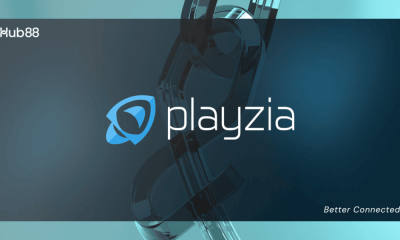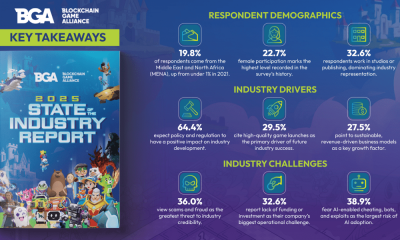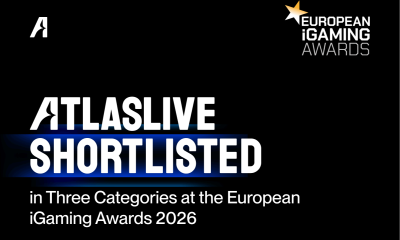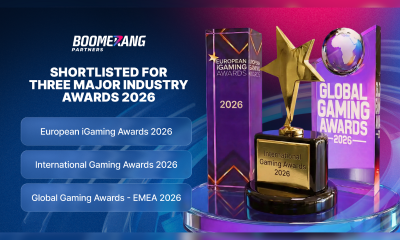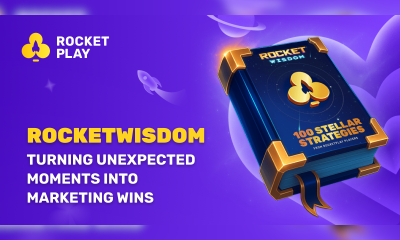Interviews
HIPTHER Community Voices: Interview with Dr. Maria Loumpourdi, founder and Managing Director of Made From Within
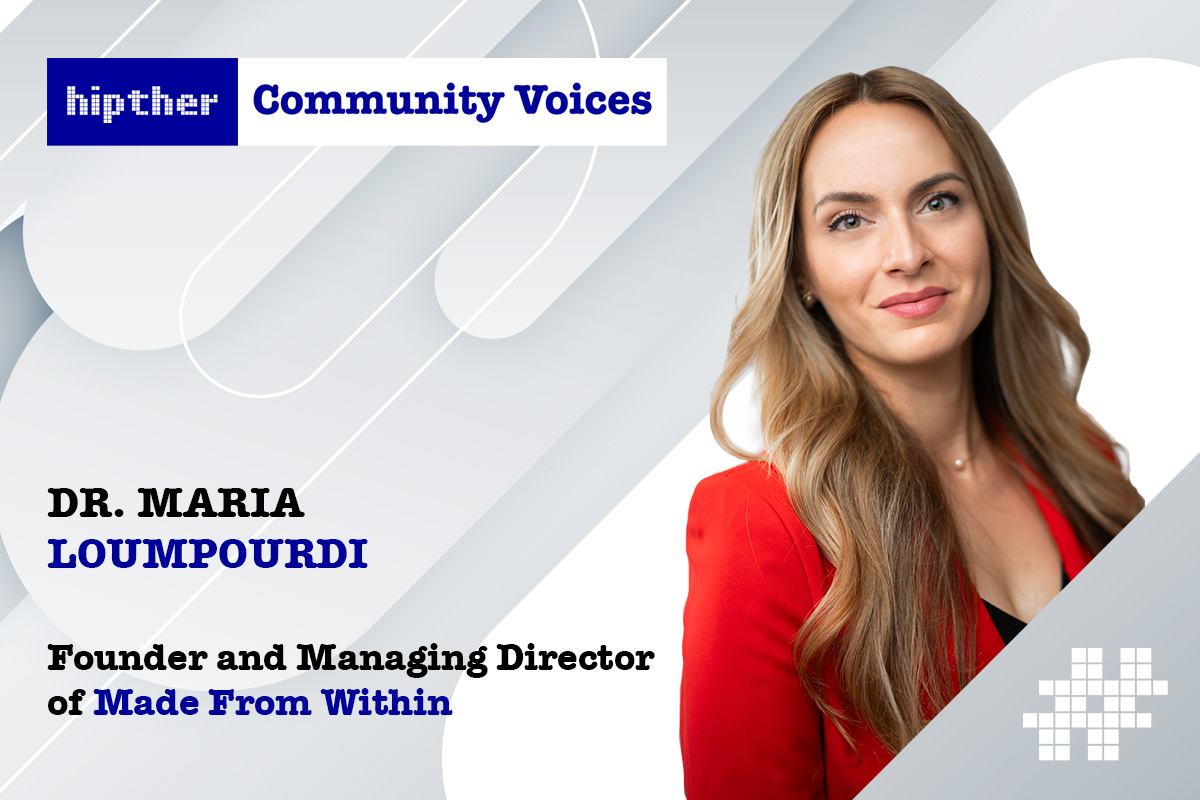
Reading Time: 7 minutes
In this interview, we speak with Dr. Maria Loumpourdi, founder and Managing Director of Made From Within, a CPD-accredited leadership development provider. She shares her journey into leadership and coaching, the philosophy behind her work, and how evidence-based development can drive real change—particularly in high-growth sectors like iGaming.
What originally sparked your interest in leadership development and coaching? Was there a defining moment that set you on this path?
The spark started very early. As a kid, I was always very curious and loved learning, but more than that, I loved sharing what I learned. I even remember trying to memorise a 24-volume encyclopaedia just so I could drop interesting facts into conversations. Looking back, that passion for learning and helping others grow was always there.
When it came time to choose a university path, education felt like the natural choice. I loved it (and still do), but I quickly started to feel uneasy about how rigid the school system is. More often than not, we teach what’s prescribed, not necessarily what kids want or need to learn. That made me think more seriously about adult education, where people have more agency in their development and are often more personally invested.
That decision led me to corporate learning and development. I started in the Learning & Development department of an iGaming company, and within a year, I moved into a leadership role heading L&D in the manufacturing sector. That role gave me hands-on experience in managing teams and developing as a leader myself. By that time, I had already completed a master’s in educational leadership and had been accepted into a doctoral programme. At that point, I already knew my research would focus on leadership development.
Another key realisation came when I started developing leaders. I began to see that while training is a necessary first step, it cannot, on its own, lead to lasting behavioural change. That’s when I realised coaching was the missing piece; it’s what helps people truly internalise and apply what they’ve learned. I became an accredited coach and eventually a coaching supervisor (a coach of coaches), and that shifted how I approached development.
Everything came together when I completed my doctorate and published my book, Leaders Made From Within. That was an important moment for me because it also marked the launch of my company, Made from Within. It was the point where everything aligned: my love for learning, leadership, developing others, and the belief that real change (whether individual or organisational) comes from within.
Made From Within is CPD-accredited and globally active. What inspired you to start it, and what impact are you most proud of so far?
Made From Within wasn’t a business idea; it was the result of over a decade of real-world experience, empirical research, and a deep understanding of what works (and what doesn’t) when it comes to leadership and organisational development. I spent many years building my expertise, holding senior roles in international organisations, and seeing firsthand what drives real performance and sustainable business growth. Just as importantly, I saw the common patterns that hold people and businesses back. Many of the lessons I learned (both the successes and the hard-won mistakes) shaped the foundation of Made From Within.
I started Made From Within because I wanted to offer something practical, evidence-based, and rooted in real experience; instead of unsupported theories, popular opinions, or trends. The leadership and personal development space is currently crowded, and I was very intentional about two things: 1. making sure that my background clearly shows I am not another self-proclaimed guru on social media, and 2. ensuring this wasn’t just another one-size-fits-all offering. At Made From Within, we don’t do off-the-shelf. We work closely with clients to understand their goals, context, and challenges, then build tailored solutions that reflect their reality. We’ve also developed CPD-accredited programmes for individuals and teams who want to grow in a structured and credible way.
What I’m most proud of is how much we’ve achieved in such a short time. Made From Within has already supported leaders and teams across organisations and industries, enabling behavioural and organisational change. We’re now expanding access by offering our accredited courses directly through our website, which allows more people to develop themselves on their own terms, and at their own pace.
Your career spans several industries—from banking and manufacturing to iGaming. What pivotal experiences have shaped your leadership philosophy?
While some leadership challenges (like earning trust, managing conflict, or leading through change) are universal, I’ve found that every industry comes with its own unspoken rules and unique pressures. The culture portrayed on the company website is rarely (if ever) the full picture. Experiencing these differences first-hand has taught me that effective leadership isn’t about following one fixed approach. It’s about learning when to listen, when to challenge, and how to earn credibility in novel environments.
One of the experiences that shaped my approach happened in my very first week as a department head in the manufacturing sector. I was asked to represent the function in a customer audit, even though I had just stepped into the role and barely had any exposure to the industry or the company. During the audit, the client questioned how certain KPIs were calculated. I hadn’t prepared the presentation and didn’t have the answer. It would’ve been easy (and probably expected) to say, “I’m new”, or shift the blame to the person who created it. But I saw it as an opportunity to lead.
I admitted I didn’t have the answer at that moment and promised to come back with it by the end of the day. When I approached the team member who had prepared the figures, they told me they couldn’t remember. This person was already on their way out of the company, having previously received feedback that they weren’t ready for the role I had stepped into. Still, I didn’t point fingers. I worked with the team to find the answer, verified the data, and returned to the client with a clear explanation. We earned the client’s trust, salvaged the audit, and celebrated with the team despite the initial mistake.
That experience grounded one of the core principles of my leadership philosophy: when you lead, you take ownership. You don’t blame others, you don’t throw people under the bus, and you don’t step back when things go wrong. If you’re in a leadership role, you take responsibility and step up even when it’s not directly your fault. That’s the kind of leader I’ve worked to be across every industry I’ve been part of.
In iGaming, rapid growth often outpaces structured development. How can coaching help companies build stronger leadership pipelines during periods of scale?
In iGaming, growth often happens so quickly that people find themselves in leadership roles before they’ve had the time (or the opportunity) to develop the skills or confidence to lead. Coaching helps bridge that gap. It provides a safe space for new and emerging leaders to speak openly about their challenges, reflect on their behaviours, set development goals for themselves and their teams, and work toward those goals with a coach acting as both a thinking partner and an accountability partner.
It’s just as valuable for senior leaders. Coaching can help them build executive presence and avoid slipping into autopilot decision-making, which, in a fast-paced environment like iGaming, can have serious long-term consequences for both individuals and the business.
I’ve seen the impact of coaching firsthand. I’ve worked with people who were on performance improvement plans (essentially on their way out), and within six months, they were promoted into leadership roles. What changed? Their mindset, their behaviour, how they communicated, how they built relationships, and how they demonstrated their competence. Coaching made that shift possible.
Coaching meets people where they are, which is exactly what’s needed during periods of rapid scale. Especially in iGaming, where employee turnover often reaches or exceeds 30% (meaning one in three employees leave each year) offering coaching, even as a smaller operator or supplier, can be the difference between losing talent (often to competitors) and building a strong leadership pipeline.
What advice would you give to iGaming companies looking to invest in leadership development for the first time? Where should they start?
My key piece of advice is this: don’t buy off-the-shelf leadership development programmes. Every year, over $360 billion is invested on leadership development globally, but only 10–20% of that has a measurable return on investment. The reason? Most programmes aren’t tailored to the actual needs of the business and its leaders.
If you want real impact, you need to start with a proper analysis of your organisation’s current leadership needs and challenges. Get clear on what effective leadership looks like in your organisation, involve senior leadership teams from the beginning, and design a programme that fits; not just something that looks good on paper. When done right, tailored programmes can achieve up to 10x the ROI.
In my book Leaders Made From Within: The Blueprint for Developing Leadership in Individuals and Organisations, I share the 5D Leadership Development Process (Define, Design, Deliver, Deploy, and Debrief), a model grounded in my doctoral research. It’s a practical, evidence-based process to building leadership capability, and it’s especially relevant for high-growth sectors like iGaming.
What skills or leadership traits are most important for success in iGaming—and how can coaching help develop them?
Success in iGaming requires a combination of leadership skills due to the industry’s fast pace, volatility, and competitiveness. In my experience developing talent in this industry, some of the most critical skills include:
- Self-awareness and self-regulation: Leaders need to manage themselves under pressure and stay grounded. Coaching supports this by helping individuals recognise patterns, triggers, and habits; and understand how these affect their performance and relationships in a structured way.
- Building relationships and networks: In a fast-moving and relatively young industry, strong cross-functional collaboration is essential. Coaching helps leaders improve their communication, influencing, and trust-building skills, especially when leading international teams where alignment is harder to achieve.
- Creativity and innovation: iGaming leaders often face ambiguous situations without a clear playbook. Coaching provides space to step back, think differently, challenge assumptions, and explore new solutions, which is something daily operations rarely allow time for.
- Decision-making: Rapid scaling requires leaders who can make informed, timely decisions without having all the answers. Coaching helps leaders gain clarity, improve their judgment, overcome indecision, and build confidence in high-stakes or complex situations.
- Business acumen: Leaders need a broader understanding of how the business operates, not just within their own function. Coaching encourages a more strategic mindset by connecting day-to-day decisions to long-term business outcomes. For example, a commercial leader should understand product development, and vice versa. Everyone needs at least a baseline understanding of the financial and regulatory side of the business.
In short, coaching develops these skills not through theory, but through structured reflection, real-world application, accountability, and feedback.
The post HIPTHER Community Voices: Interview with Dr. Maria Loumpourdi, founder and Managing Director of Made From Within appeared first on European Gaming Industry News.
Black Cow Technology
Inside Black Cow’s Decision To Go All In On Multiplayer

Reading Time: 3 minutes
Black Cow Technology Founder and CEO, Max Francis, on why the company has shifted focus from software development to game development, and why he believes multiplayer is the future of online gambling entertainment
Black Cow has just announced its transition into a multiplayer content provider. What made you refocus the business in such a way?
We truly believe that multiplayer is the future of online gambling entertainment, and with our own technology capable of building next-gen multiplayer experiences, we wanted to transition into a content-led business and release some innovative games of our own. Our Multiplayer RGS is especially powerful, allowing operators and suppliers to bring multiplayer gameplay to any game format, even including non-gambling events. Black Cow’s robust, reliable and highly flexible technology is already used by some of the biggest organisations in the industry, including the likes of DraftKings and Light & Wonder. The shift into creating our own multiplayer content enables us to build on our successful Remote Game Server (RGS) and Jackpot Server technology to create first-of-its kind games offering unique player experiences via our Multiplayer RGS platform.
Tell us more about your Multiplayer RGS and its capabilities. What sets it apart from similar solutions in the market?
Our Multiplayer RGS has been several years in the making and is already live with Light & Wonder. Our Multiplayer RGS can be used to create multiplayer experiences across anything from slots and table games to crash, plinko, lottery, live dealer and bingo. Games can be player-cooperative or player versus player. The system’s capabilities are really only limited by the imagination of the people using it, and that’s why we’re so excited to be moving into the realm of game development so that we can push its limits to disrupt online casino lobbies with Black Cow content.
Taking a business in a new direction is a significant undertaking, not without its risks. How have you approached this transition?
It was clear to me that we had the technology to create multiplayer content, but not necessarily the experience to date, and that’s why we’ve been making strategic hires. This year we have promoted Paul Jefferson to the role of Chief Technical Officer and we have welcomed two more big-hitters to the business – Ernie Lafky as Chief Product Officer and Shelley Hannah as Chief Operations Officer. Ernie is taking the lead when it comes to what our games will look like and how we combine key elements like multiplayer, gamification and social interaction. Shelley is managing the operational aspects of our transition to a hosted product-first model. In terms of mitigating the risk, it comes down to the deep rooted confidence we have in our technology and our fantastic team, plus our belief that players are seeking social multiplayer entertainment.
Why do you have such a firm belief that multiplayer content is the future? And to what extent will it dominate online casino game lobbies?
It’s not the future, it’s the now. You just have to look at the experiences offered by other online entertainment options to see that they are becoming increasingly multiplayer and social. From dating to streaming, social media to mobile gaming, consumers want to engage with products and experiences that can be enjoyed with others. But online casino and sports betting sit at odds with this as they have been, and remain, mostly solitary experiences. We have started to see a bit of a shift away from this, first with live casino and then the rise of the crash game format. But this is just the start of what multiplayer online gambling entertainment can look like, and at Black Cow we have the vision, people and technology to really spearhead the multiplayer movement and be a true leader in the space.
As for the degree to which multiplayer content will dominate online casino and sportsbook lobbies, I think it has the potential to be significant but there will always be players that want to engage with more traditional games, products and experiences, so it will be down to each operator as to how they promote multiplayer games. Naturally, this approach will differ from brand to brand based on their specific player-base.
What can we expect from Black Cow now that your transition into a multiplayer game developer is well underway?
Paul, Ernie, Shelley and the team are working hard on our initial product roadmap, including the first run of games that will leave our production line. This is a really exciting moment for me and the whole team, as it will bring our vision to life and set the blueprint for what our multiplayer games will look like moving forward. It goes without saying that our multiplayer games will embody the core values we have built Black Cow on – reliability, flexibility and robustness. This is a big change for Black Cow, and change does bring challenges. But we are all aligned and excited by the new direction. Success is never guaranteed, but we are walking into the next chapter of the Black Cow story confident that it will be our best yet.
The post Inside Black Cow’s Decision To Go All In On Multiplayer appeared first on European Gaming Industry News.
Interviews
Scaling With Purpose: RedCore’s Tech Vision Explained

Reading Time: 7 minutes
At SiGMA Central Europe in Rome, European Gaming Media sat down with Yevhenii Yankovyi, Vice President of Technology and Deputy CTO at RedCore, for a deep look into what truly powers RedCore’s large-scale engineering operations.
RedCore is known for innovating at enterprise level, yet moving with the agility of a fast-growing tech company. In this conversation, Yevhenii breaks down how the organization manages that balance: how engineering teams maintain both speed and reliability, how automation empowers creativity, and why culture must remain a daily practice rather than a one-time achievement.
Can you introduce yourself and RedCore’s approach to engineering at scale?
Sure. My name is Yevhenii, I’m the Vice President of Technology at RedCore and Deputy CTO. RedCore is a large company with many products and projects, so everything we do operates at a significant scale. And when people hear “enterprise-level engineering,” the usual assumption is that scale automatically means slowness: slow decision-making, slow implementation, slow testing, slow time to market.
That’s the mindset we challenge. We don’t believe speed and stability are opposites. In our experience, at this level of complexity, the two actually reinforce each other. When you build the right processes, the right technical foundations, and the right organizational structure, speed becomes a natural result of stability – not something that contradicts it.
We plan for scaling from day one. For us, that’s a fundamental requirement. We build products with the expectation that they will grow, and growth means scale. So we design with that in mind from the very first line of architecture.
But that doesn’t mean disappearing for six or ten months to design the “perfect” system. That’s the common mistake people make when they hear “design for scale.” Our approach is different: we keep the long-term vision in mind, but we move fast, iterate, and make sure the product can evolve without slowing the team down. Stability and speed working together – that’s the engineering culture we build at RedCore.
How does RedCore balance speed and stability in daily engineering?
I will explain this with a simple metaphor: think about a car. Everyone talks about acceleration and top speed, but none of that matters if you can’t take a corner. Speed alone is not the winning formula – you also need control.
That’s exactly how we look at engineering at RedCore. We want to accelerate, make decisions quickly, and develop fast. But we also need the ability to slow down at the right moment, change direction, and stay agile. Balancing speed with stability is the only way to move at scale.
There are many layers to this – it’s a topic I could talk about for days – but in a nutshell:
at a big scale, you must have strong standards, clear policies, and a high level of automation. We rely heavily on automation: infrastructure as code, CI/CD pipelines, automated testing, and all the tools that remove repetitive, routine work from engineers’ daily lives. When the routine disappears, people can focus on what humans actually do best: creativity, problem-solving, and innovation.
However, automation doesn’t build the software for you. It creates a safety net. It catches mistakes, guards quality, and supports engineers when their creativity pushes boundaries. In other words: tools give freedom, and also protect that freedom.
And of course, this includes AI and many other modern tools. We use whatever helps us keep the balance: give people space to think, create, and experiment, while ensuring the system stays stable, predictable, and high-quality.
How does RedCore’s management keep teams aligned yet fast?
First of all, we provide clear goals. As I mentioned earlier, we always design for scale from day zero – but you can only do that if you know exactly what you’re building, for whom, and why. We have a very strong business team that understands the market and what needs to be delivered. The technology team works side by side with them, reinforcing them.
Once the goals are clear, we begin small. If you try to build a huge system from the beginning and get it wrong, you create a nightmare: something no one can support, change, or grow. Complexity grows exponentially, and humans don’t think exponentially; we think linearly. That’s where companies often get lost.
So we avoid that by validating early and validating often. We start with small steps, keep a close eye on every direction we take, and confirm that what we’re building is truly needed by the market. When we see that the direction is right, then we scale – and by that point, the foundation is already in place. It’s like preparing a launchpad so that when the time comes, the team can accelerate immediately.
We build block by block and work in iterations. We take a small team – one, two, maybe three people – and let them experiment for a week. We test the idea fast, get quick feedback, and bring it to the business side: “Do you like it?” If the answer is yes, then we continue, still following all the proper engineering practices before anything goes into production.
This constant loop between business and technology keeps everyone aligned. We give feedback, we receive feedback, and we move together. That’s how we stay both fast and coordinated, always ready to scale when the direction is confirmed.
How does automation empower engineers without slowing them down?
When we talk about automation, we’re really talking about optimization at scale. It doesn’t make sense to over-engineer small things, but at the scale we operate, the cost efficiency and speed gains are enormous. And people often assume that big systems and automation automatically slow everything down. For us, it’s the opposite.
The tools we introduce are not meant to tie engineers’ hands with bureaucracy. We don’t force strict guidelines or heavy processes that kill creativity. Our tools exist to help: to prevent mistakes, to collect feedback quickly, and to give teams the shortest possible path from idea to validation.
Here’s a simple example: we start experimenting with a small feature. We build a tiny prototype to see if the idea works. If it’s promising, the next step is testing, pipelines, deployment – all the things that normally take time. In many companies, engineers would try to do all of this manually because “building the tools will take too long.” But with us, the tools are already there. The infrastructure, the CI/CD, the automation – everything is ready to use. Our engineers are essentially customers of this internal platform that supports fast, safe delivery.
We have many different teams that have different great ideas. If one team tries something new and it works better, great – we learn from it. If another team has a different approach because of product specifics or release schedules, that’s fine too. We give freedom to the teams to work, share their experiences, and then scale.
Of course, there are non-negotiables. When it comes to security and data privacy there is zero tolerance. These are areas where strict rules are absolutely necessary. I always tell the security people: everyone should be a little afraid of you, because these things must be perfect. But outside those critical areas, we don’t impose rules that slow teams down. We experiment, gather feedback, adjust, and keep improving.
We’re constantly researching, experimenting, and customizing our automation depending on the product and the market. But when it comes to system design, we don’t reinvent the wheel. We choose globally recognized tools and industry-validated technologies. So yes, we empower engineers with automation and the right tools, built on a solid, modern foundation.
How does culture work for you – is it an achievement, or part of your routine?
Culture is a critical element in balancing speed and stability. Tools and processes matter, but culture is what truly empowers a team and keeps everything together at scale.
For us, culture starts with giving people freedom: the freedom to experiment, the freedom to make mistakes, and the freedom to challenge ideas. We don’t want engineers to be afraid of trying something new. We build a culture where mistakes are acceptable and manageable. If we try something and it doesn’t work, great – now we know better. We learn, adjust, and move on.
We encourage ideas from every level. Some of our most interesting insights come from developers who notice something while working on a small task. They can come directly to me or to the CTO and say, “I see a problem here.” It’s completely okay. A small detail in one corner of the system can become a huge issue at scale, so we listen. That’s how we avoid blind spots.
We also give teams autonomy. Small teams can make their own decisions and experiment in their own ways. If different teams want to do things differently, that’s fine – as long as they validate everything and share their findings. We want people to help each other and to understand that even top engineers have ups and downs. Even senior management makes mistakes. I constantly ask my team: “If I make a wrong decision, tell me.” It’s not about transparency as a buzzword – it’s about behavior. People observe how you respond, and they learn from that.
The biggest mistake any leader can make is demotivating people. We work with intelligent, educated, passionate professionals. They want to contribute. You just need to give them the space to do it. That’s when you see people shine and bring forward brilliant ideas.
As for the question of whether culture is an achievement or a routine – for us, it’s definitely a routine. People often talk about “building a strong engineering culture” as if it’s a success. We treat it as a routine as a process. Culture is the daily interactions between people in an organization. Those interactions change: people come and go, someone has a bad day, someone disagrees with a decision. Culture is shaped every day by how we communicate, how we argue, how we respect each other, and how we resolve differences.
Going to a colleague in the kitchen and asking, “Hey, what do you think about this?” – that’s culture. Anyone can talk to anyone, openly. And when engineers realize they can make a real impact, that they are heard, that they can influence the product — that motivates them. That’s what keeps the culture alive.
How do you balance standards with creative freedom?
The first thing is that we don’t pressure people. We set strict standards only where they are truly critical for the business. Security, data privacy, stability at scale – those areas demand clear rules. But everywhere else, we try not to push people. And when we do introduce a standard or guideline, we listen carefully to feedback. If the team tells us we made the wrong call, that’s okay – we rethink it and look for better approaches.
The second thing is that as the projects grow, the teams scale as well. Even in the design phase, we don’t start with a huge team. I prefer a small group: one key person who leads the design initiative, plus two or three contributors who constantly review, test, question, and give feedback. If three or four people align in one direction, that’s a good signal we’re on the right track. Then we take that proposal to a larger group – people who might use it or need it.. We refine it again based on their input. The idea evolves, but we don’t need to start from the beginning.
Finally, when we have a strong direction, we present it to the entire tech team. And even then – even if top management already supports the decision – it’s completely acceptable for a mid-level developer to raise concerns. Maybe they’ve seen something before, maybe they read an article, maybe they faced a similar issue. We listen, because at scale, one overlooked detail can cost millions.
So once again, balancing standards with creative freedom is about scaling the processes step by step: we start with a small group, validate in small cycles, and then scale the decision up gradually. This approach protects creativity, ensures high quality, and keeps us aligned. And combined with our culture, it makes the process both fast and safe.
The post Scaling With Purpose: RedCore’s Tech Vision Explained appeared first on European Gaming Industry News.
HIPTHER
How to Write a CV that Attracts Top Employers – Insights by Valeriia Virchenko, Head of Talent Acquisition at RedCore

Reading Time: 4 minutes
European Gaming Media joined RedCore and Valeriia Virchenko, Head of Talent Acquisition, at their SiGMA Central Europe booth in Rome to discuss a topic that resonates with every ambitious professional: how to write a CV that truly stands out to top employers.
As an accomplished recruitment leader with extensive experience across continents – from Europe to Latin America, Africa, and Asia – Valeriia brings a global perspective on what leading companies seek in candidates today. Under her leadership, RedCore’s talent acquisition strategy continues to attract and develop exceptional professionals across tech, marketing, and fintech.
Interview by Maria Emma Arnidou, HIPTHER – European Gaming Media
Valeriia, from your experience leading large-scale recruitment projects across international markets, what makes a CV truly stand out to top employers today?
First of all, thank you for the invitation. From my experience, what really makes a CV stand out is when candidates clearly show their results and impact. Top companies want evidence of what you achieved, not just a list of responsibilities. It’s important to include metrics or numbers – for example, not just “I managed a large team,” but “I led a team of 15 and increased results by 20%.” These details matter. Employers want to see how your experience directly helped solve problems or improved something within the company.

What are the most common mistakes candidates make when writing their CVs, and what advice would you give them to avoid these pitfalls?
This is a big topic, but in my opinion the most common mistake is that some CVs are simply too long. Hiring managers can only scan a CV briefly, so two pages, three at most, is enough. Writing a very long CV is a major mistake. Another point is simple but often overlooked: candidates really need to proofread their final draft. Small errors and little details matter because they show whether someone is attentive and pays attention to detail.
When reviewing applications at RedCore, what qualities or signals do you look for that show a candidate is ready to grow within a fast-paced, innovation-driven environment?
We mainly look for two things. The first is adaptability – people who can adjust quickly to change. The second is a genuine love of learning. We prefer hiring people with a growth mindset. How fast someone can learn new tools or approaches is very important for us, because our industry is extremely dynamic. If a person doesn’t like learning or isn’t open to new technologies, it becomes difficult to work together in such an environment.
On a CV, it helps a lot when candidates highlight this. If you started a new project, learned a new tool quickly, or solved a significant problem at work – mention it. These signals show us that you’re ready to grow with us.
RedCore is actively hiring specialists across various sectors – also C-level professionals. What can experienced candidates expect when joining your organization in terms of career growth and support?
We can talk about perks, benefits, high salaries – and of course we have all of that – but so does everyone. What I really want to highlight, especially for C-level candidates, is something different. If you look at our booth here at SiGMA Central Europe, you can see how big it is – because it houses the many brands : Mr. Booster, Frogo, PayPartners, and others. Each of these brands has its own C-level professionals, and these leaders grow inside our company.
What we offer C-level professionals is ownership and creative freedom: the opportunity to act like business owners. They can take a product from idea to market, understand what needs to be done, build the right sales strategy, and really drive the product forward. They get the freedom and responsibility of running a business, but in a comfortable environment and with minimal risk. You can focus purely on growth and vision.
And one more thing that’s very important for us: we always welcome C-level candidates to visit our booth at expos. We want to meet them, to get to know them, even if they are not actively looking for a new role right now. There are always opportunities, and we are always open to talent.

Finally, for those aspiring to join global companies like RedCore, what’s your number one piece of advice for crafting a CV that stands out and secures an interview?
Be very clear about your sector. If you work in fintech, iGaming, healthcare – mention it right away, because it immediately gives us an understanding of your background. These industries are not the same, and this context matters. The same goes for technical roles: if you’re a developer, list your full tech stack clearly. Which technologies, which tools – everything should be easy to find.
Structure and presentation are also important. It’s better to build your CV using a proper layout tool like Canva or Tilda, rather than leaving it as a plain Google Doc. Think of it like a user journey: recruiters and hiring managers should instantly know where to find the right information about you.
And finally, include a photo: a simple, professional portrait. Sometimes we see funny photos, and that’s not the impression you want to give when applying to a global company. You don’t need a studio shoot; even a phone photo taken against a white or grey wall is enough. People want to see who they might be working with in the future.
Thank you, Valeriia, for sharing your valuable insights on building a career-ready CV and giving us a closer look into RedCore’s approach to talent and professional growth.
RedCore is hiring – View the job openings & build your dream career with them!
Stay tuned for more exclusive interviews from SiGMA Central Europe 2025, brought to you by European Gaming Media, your trusted source for insights at the intersection of iGaming, tech, and innovation.
The post How to Write a CV that Attracts Top Employers – Insights by Valeriia Virchenko, Head of Talent Acquisition at RedCore appeared first on European Gaming Industry News.
-

 Andrew Jackson6 days ago
Andrew Jackson6 days agoScientific Games Adds to Information and Security Management Certifications, Continues Setting Global Industry Gold Standard
-

 Eastern Europe6 days ago
Eastern Europe6 days agoHIGHLIGHT GAMES LIVE IN ROMANIA WITH FORTUNA ENTERTAINMENT GROUP
-

 Best Solutions for iGaming Industry in Romania 20256 days ago
Best Solutions for iGaming Industry in Romania 20256 days agoSoft2Bet Nominated for Best Solutions for iGaming Industry in Romania 2025
-

 Australia6 days ago
Australia6 days agoBetMakers Signs Multi-Year Agreement to Launch CrownBet
-

 Latest News6 days ago
Latest News6 days agoAtlaslive Shortlisted in Three Categories at the European iGaming Awards 2026
-

 Latest News2 days ago
Latest News2 days agoBoomerang Partners has been included in 3 prestigious industry Awards, which will be presented in January 2026
-

 Balkans5 days ago
Balkans5 days agoBragg Gaming Wins Online Platform of the Year at BEGE Awards 2025
-

 Latest News6 days ago
Latest News6 days agoHow RocketWisdom Turned From An Internal Activity Into a Marketing Case











